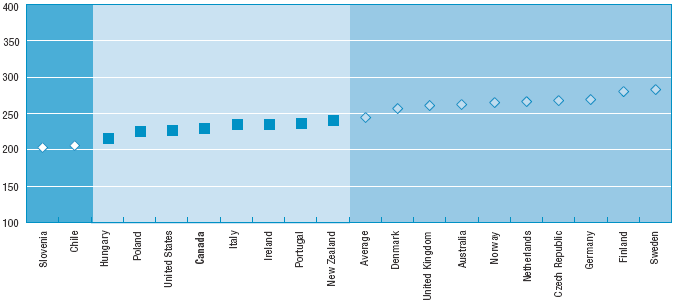
High school completion has become a minimum education standard for young people in the United States today. U.S. National Education Goal 2 states that by the year 2000, the high school graduation rate will increase to at least 90 percent. By 1997, 17 out of 51 states had already achieved a 90 percent high school completion rate. The opposite of high school completion is high school dropout, which happens when young people in grades 9 through 12 leave school without completing a recognized secondary program. A multitude of evidence from various sources indicates not only that this population faces severe handicaps in entering stable employment and making ends meet economically but also that their labor market prospects have worsened over the last decade.
Figure 2 presents the prose mean scores of the population aged 20-25 who left secondary school without a recognized program in the 19 countries for which comparable data are available. It can readily be seen that the mean score of U.S. high school dropouts is among the lowest of the countries investigated. Only Slovenian and Chilean youth score significantly lower. High school dropouts in Canada and the United States have the same level of prose literacy but U.S. youth perform slightly better on the document scale. In about half the countries high school dropouts score significantly better than their counterparts in Canada and the U.S.
Mean prose scores on a scale with range 0-500 points, for those with less than upper-secondary education, population aged 20-25, 1992-1998

Legend:
![]() Nations with mean scores significantly lower than the United States
Nations with mean scores significantly lower than the United States
![]() Nations with mean scores not significantly different from the United States
Nations with mean scores not significantly different from the United States
![]() Nations with mean scores significantly higher than the United States
Nations with mean scores significantly higher than the United States
COUNTRIES ARE RANKED BY THE STATISTICAL DIFFERENCE TO THE UNITED STATES.
Note: Statistical difference is significant at p < .05.
Source: International Adult Literacy Survey, 1994-1998; US National
Adult Literacy Survey, 1992.